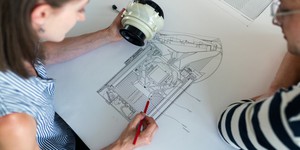Log In
Summary
*Note:
For this science project you will need to develop your own experimental procedure. Use the information in the summary tab as a starting place. If you would like to discuss your ideas or need help troubleshooting, use the Ask An Expert forum. Our Experts won't do the work for you, but they will make suggestions and offer guidance if you come to them with specific questions.
If you want a Project Idea with full instructions, please pick one without an asterisk (*) at the end of the title.
If you want a Project Idea with full instructions, please pick one without an asterisk (*) at the end of the title.
Abstract
If you have an air hockey table, you know that the puck floats on a thin cushion of air when the table is turned on. With little friction, the puck can travel very fast. How much lift force is created by the air? Add small amounts of weight to the puck and see when it no longer floats to measure the lift force. How many air holes (on average) support the puck? How much force is generated by each air hole? Will a puck with a larger surface area, supported by more air holes (on average), support more weight in proportion to its area? (Remember to include the weight of the puck in the measurement.) Make your own test shapes by cutting thin cardboard or polystyrene sheet (from a hobby shop, or use old CD cases). Is lift generated if the puck has a rough surface? Tape sandpaper on one side of the puck, test, then flip it over as a control. What about other surfaces (different types of cloth, for example)?Ask an Expert
Do you have specific questions about your science project? Our team of volunteer scientists can help. Our Experts won't do the work for you, but they will make suggestions, offer guidance, and help you troubleshoot.
Global Connections
The United Nations Sustainable Development Goals (UNSDGs) are a blueprint to achieve a better and more sustainable future for all.
This project explores topics key to Industry, Innovation and Infrastructure: Build resilient infrastructure, promote sustainable industrialization and foster innovation.
Careers
If you like this project, you might enjoy exploring these related careers:
Career Profile
Mechanical engineers are part of your everyday life, designing the spoon you used to eat your breakfast, your breakfast's packaging, the flip-top cap on your toothpaste tube, the zipper on your jacket, the car, bike, or bus you took to school, the chair you sat in, the door handle you grasped and the hinges it opened on, and the ballpoint pen you used to take your test. Virtually every object that you see around you has passed through the hands of a mechanical engineer. Consequently, their…
Read more
Career Profile
You use mechanical devices every day—to zip and snap your clothing, open doors, refrigerate and cook your food, get clean water, heat your home, play music, surf the Internet, travel around, and even to brush your teeth. Virtually every object that you see around has been mechanically engineered or designed at some point, requiring the skills of mechanical engineering technicians to create drawings of the product, or to build and test models of the product to find the best design.
Read more
Career Profile
Physicists have a big goal in mind—to understand the nature of the entire universe and everything in it! To reach that goal, they observe and measure natural events seen on Earth and in the universe, and then develop theories, using mathematics, to explain why those phenomena occur. Physicists take on the challenge of explaining events that happen on the grandest scale imaginable to those that happen at the level of the smallest atomic particles. Their theories are then applied to…
Read more
Related Links
- Science Fair Project Guide
- Other Ideas Like This
- Aerodynamics & Hydrodynamics Project Ideas
- My Favorites
Cite This Page
General citation information is provided here. Be sure to check the formatting, including capitalization, for the method you are using and update your citation, as needed.MLA Style
Science Buddies Staff.
"Aerodynamics of Air Hockey." Science Buddies,
20 Nov. 2020,
https://www.sciencebuddies.org/science-fair-projects/project-ideas/Aero_p024/aerodynamics-hydrodynamics/aerodynamics-of-air-hockey?class=AQVaTMWLiD8p0OC6LcZ0thPERs7zrfKwFDoJvu9QmdYaCcX6fvu6T7BrtCzLGGxGh-Fk2lXE6Mfbh2JAD0wZYCQj.
Accessed 26 Apr. 2024.
APA Style
Science Buddies Staff.
(2020, November 20).
Aerodynamics of Air Hockey.
Retrieved from
https://www.sciencebuddies.org/science-fair-projects/project-ideas/Aero_p024/aerodynamics-hydrodynamics/aerodynamics-of-air-hockey?class=AQVaTMWLiD8p0OC6LcZ0thPERs7zrfKwFDoJvu9QmdYaCcX6fvu6T7BrtCzLGGxGh-Fk2lXE6Mfbh2JAD0wZYCQj
Last edit date: 2020-11-20
Explore Our Science Videos
DIY Mini Propeller Car
Junkbots Lesson Plan Introduction
How to Build a Toy Car - Science Project










